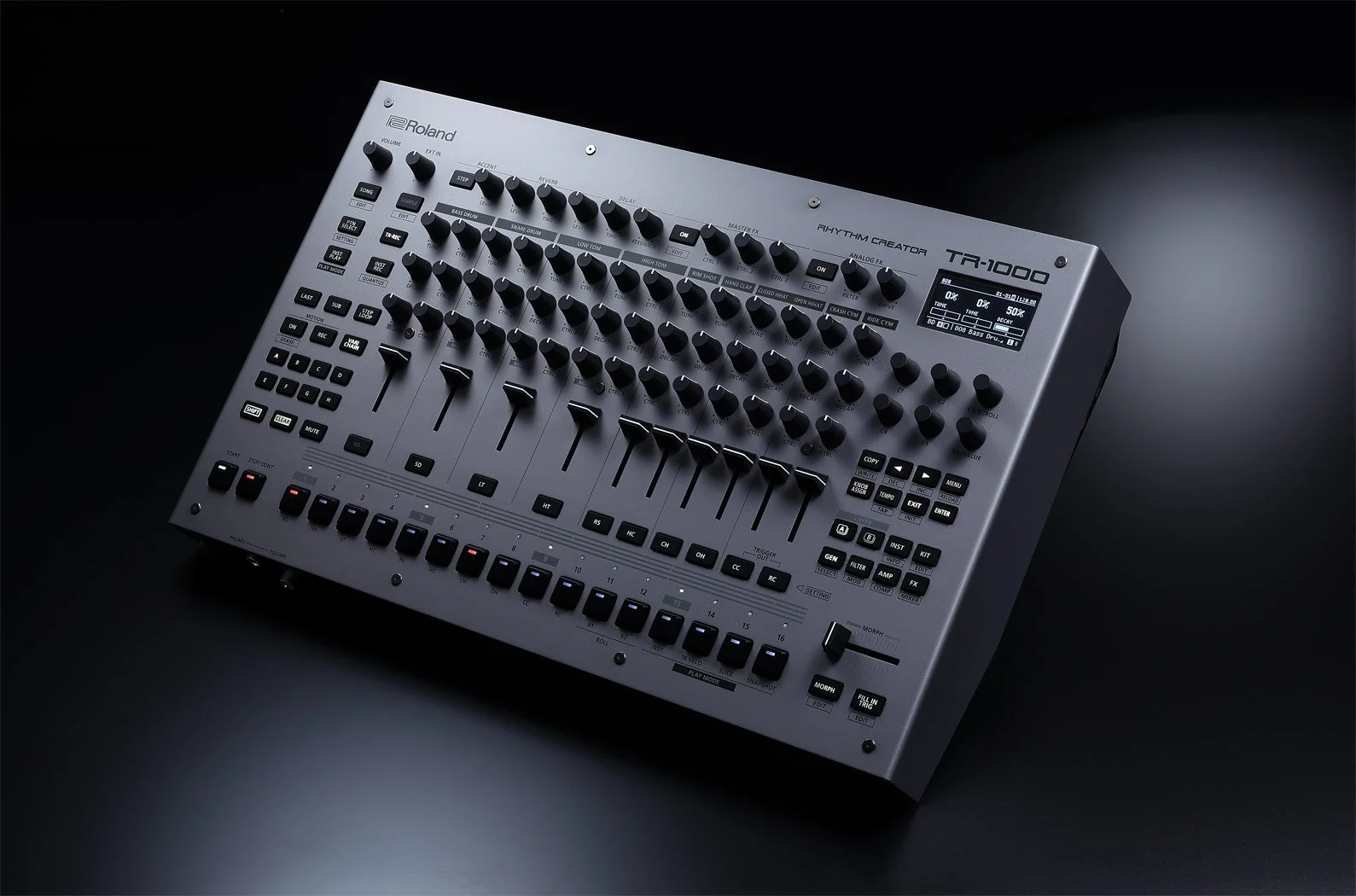Roland TR-1000: Meet the First Analog TR Drum Machine in 40 Years

Roland has done something many thought they’d never do again: release a brand-new TR drum machine with actual analog circuits inside. The TR-1000 isn’t just another digital box with 808 samples baked in. It’s the first time in over 40 years that the company has built a true analog rhythm machine, a lineage that stretches back to the immortal TR-808 and TR-909. That alone makes it historic. But the TR-1000 isn’t stuck in the past. Roland has framed it as a hybrid powerhouse, combining freshly engineered analog voices with their ACB modeling, FM percussion, PCM, and even full stereo sampling. The pitch is simple: take the weight and punch of vintage hardware, mix it with modern engines and sequencing, and give artists a single flagship box to build entire tracks from. Whether it lives up to that ambition is another question — and that’s where this review begins.
This site contains affiliate links. If you book or purchase through these links, I may earn a commission at no extra cost to you. This helps support the site and keeps my content free. As an Amazon Associate, I earn from qualifying purchases.
What Is the TR-1000?
At its core, the TR-1000 is Roland’s boldest rhythm machine in decades. Instead of relying purely on modeling like the TR-8S or TR-6S, the TR-1000 brings back true analog circuits — sixteen of them, carefully recreated from the original TR-808 and TR-909 designs with modern components. That makes it the first new Roland drum machine since the early ’80s to actually generate sound in hardware rather than simulate it, a move that instantly raises the stakes for how it’s judged.
But Roland didn’t stop at analog nostalgia. The TR-1000 is a hybrid platform that pulls in every major technology the company has worked on since the vintage TR era. Alongside its analog drum voices, you get ACB (Analog Circuit Behavior) models, FM percussion, PCM sounds, and a powerful sampling engine with full stereo recording, slicing, and resampling. In other words, this isn’t just a box of kicks and snares — it’s meant to be a full rhythm workstation where you can blend classic tones with modern textures and your own recorded material.
Roland has also been open about how the TR-1000 was developed: they didn’t just engineer in a vacuum. The company involved artists and producers early in the process to make sure the instrument balanced flagship-level depth with intuitive workflow. The result is a machine that looks equally aimed at studio producers who want the “real thing” and live performers who need flexibility on stage.
So while the headline might be “Roland goes analog again,” the deeper story is that the TR-1000 is more than just an 808/909 rehash. It’s pitched as a new flagship that tries to carry the TR legacy forward — with a design that feels as much about future-proofing as it does about honoring the past.
Sound & Character
If there’s one thing people expect from a TR machine, it’s a kick that rattles the room and hats that slice clean through a mix. The TR-1000 doesn’t shy away from that expectation. With its 16 newly engineered analog circuits drawn from the TR-808 and TR-909, the core sound palette has the weight and punch you’d hope for. The kicks land with authority, the snares have that crisp snap, and the toms carry the familiar boomy resonance that made the originals legendary. Roland is promising not just “808-style” or “909-style” tones, but the real deal recreated in hardware.
The interesting part is how those analog voices sit alongside the digital engines. ACB models let you expand into variations of the classics, while FM and PCM open up metallic hits, tuned percussion, and more contemporary flavors. Then there’s the sampling side, which brings in loops, chopped breaks, and resampled layers. This combination means you’re not boxed into retro beats — you can move seamlessly between pure analog thump and modern, sound-designed kits. For producers who like contrast and texture, that flexibility is a huge selling point.
Still, there are a few open questions. While the kicks, snares, and toms are likely to shine, cymbals and hi-hats have always been trickier to get right in analog form. The TR-1000’s fidelity in that area will only be proven once people start pushing it in real sessions. Likewise, how well the sampling integrates into performance workflows is something to watch. But overall, the TR-1000’s sound character feels like its strongest argument: it’s an analog backbone with digital reach, capable of covering both faithful recreations and unexplored rhythmic territory.
Sequencing & Performance
A TR machine lives or dies by its sequencer, and the TR-1000 is built to feel like both a classic and a modern tool. The familiar TR-REC workflow is here, letting you punch in steps quickly and get patterns running in seconds. But Roland has expanded it well beyond the vintage playbook: patterns can stretch up to 128 steps, with options for probability, parameter automation, and variations that make beats less rigid and more alive.
Performance tools also go deeper than before. The morphing function lets you blend between different kit states or parameter snapshots in real time, which is ideal for builds and breakdowns during a set. Snapshot recall makes it possible to jump between whole variations of a pattern instantly, and combined with features like resampling, it gives the TR-1000 a kind of fluidity you don’t always find in hardware drum machines. It’s designed as much for improvisation as it is for static sequencing.
The bigger story here is how Roland frames the sequencer as a bridge between studio and stage. In the studio, the depth means you can program evolving tracks without external gear. On stage, the immediacy of TR-style step entry combined with live controls, probability, and morphing creates space for improvisation without losing structure. It’s a balancing act between the predictable and the spontaneous — and if Roland got that balance right, the TR-1000 could be one of their most versatile sequencers to date.
Design, Build & Connectivity
Roland clearly designed the TR-1000 as a serious flagship machine. The metal chassis feels built for the long haul, with a dense layout of knobs, buttons, and faders that give you plenty of hands-on control. It avoids the flashy LED aesthetic of Roland’s AIRA line and instead leans into a more professional, understated look. On a practical level, the layout seems intuitive — most parameters are at your fingertips without much menu diving, which is essential when you’re sequencing and performing on the fly.
Connectivity is another strong point. The TR-1000 comes with ten individual outputs, each of which can also function as trigger outs for modular or external gear. You also get stereo mix out, MIDI, USB, and CV/gate connections, plus an external input for processing other instruments through its filter and effects. This makes the TR-1000 as comfortable in a DAW-less hardware setup as it is in a modern studio rig. It’s versatile enough to be the center of a hybrid setup, driving both analog and digital gear.
Still, the design isn’t without its quirks — and here’s where it’s worth editorializing. The original TR-808 had a playful charm with its bright color-coded buttons, while the TR-909 struck a balance between minimalism and something almost toy-like, with a vintage computer vibe that made it instantly iconic. By comparison, the TR-1000 looks a bit cold. It’s slick and definitely not unattractive, but perhaps too sleek for its own good. It projects seriousness, but some personality has been lost in translation. For a machine carrying so much history, a little more visual flair could’ve gone a long way.
How Does It Compare To the Best Drum Machines?
The TR-1000 sits in an interesting space within Roland’s own lineup. Compared to the TR-8S or TR-6S, it’s vastly more expensive, but also in a completely different league. The TR-8S gives you solid ACB models and sample playback at a fraction of the price, but it doesn’t have the analog circuits or the same sequencing depth. If you only want quick access to classic 808 and 909 sounds, the cheaper boxes still make a lot of sense. The TR-1000, meanwhile, is aimed at people who want the authenticity of analog hardware and the flexibility of modern engines in one flagship instrument.
Against other brands, the Elektron Analog Rytm MkII is probably its closest rival. Elektron’s machine also combines analog voices with digital flexibility, plus a famously deep sequencer. The Rytm, however, has a different sonic character — darker, more sculptable, and less tied to the 808/909 legacy. Korg’s Drumlogue offers a hybrid approach with analog kicks and digital layers, but it’s priced much lower and doesn’t pretend to be a full replacement for Roland’s heritage. The Polyend Play+ and Akai’s MPCs also compete in terms of sequencing and sampling, though they lack the “true TR” identity that makes the 1000 stand out.
Then there’s the question of value compared to vintage. Original TR-808s and 909s now sell for many thousands of dollars, often with aging parts and reliability issues. At around $2,700, the TR-1000 is still a serious investment, but for a brand-new machine that merges both analog and digital worlds, it undercuts the vintage market while offering far more features. That pricing positions it as Roland’s statement piece: not a casual drum machine, but a flagship aimed squarely at professional producers, collectors, and performers who want the real TR sound without paying vintage collector prices.
Pros & Cons
Pros
True analog circuits — first time since the TR-808/909, with 16 voices newly recreated.
Hybrid design that combines analog, ACB modeling, FM, PCM, and full stereo sampling.
Deep sequencer with probability, morphing, and snapshot features for live performance.
Extensive connectivity including 10 individual outs, CV/gate, MIDI, USB, and external input.
Solid build quality with a professional, tactile layout that avoids excessive menu diving.
Cons
High price tag puts it firmly in pro territory, not for casual users.
Design aesthetic feels a bit too sleek and cold compared to the iconic personality of the 808/909.
Workflow depth could risk being overwhelming, depending on how sampling and sequencing integrate in practice.
Cymbals and hi-hats remain a question mark — traditionally harder to nail in analog.
Who Is the TR-1000 For?
The TR-1000 feels like Roland finally acknowledging what people have been asking for since the ’90s: a real analog TR machine that doesn’t just coast on samples or modeling. It’s a serious piece of kit, merging the character of the 808 and 909 with modern flexibility — sampling, sequencing tricks, morphing, and deep connectivity. For the right producer, it can be the heart of an entire studio or a commanding live performance rig.
That said, the TR-1000 is not for everyone. Its price makes it inaccessible to casual beatmakers who might be better served by a TR-8S, a Drumlogue, or even software solutions. And while its sound and feature set are impressive, some may find the design a little too clinical compared to the charm of vintage machines. Ultimately, the TR-1000 is a flagship aimed at professionals and die-hard TR fans: the kind of people who want the authenticity of analog circuits but also demand modern production tools in a single, powerful box.
This site contains affiliate links. If you book or purchase through these links, I may earn a commission at no extra cost to you. This helps support the site and keeps my content free. As an Amazon Associate, I earn from qualifying purchases.


